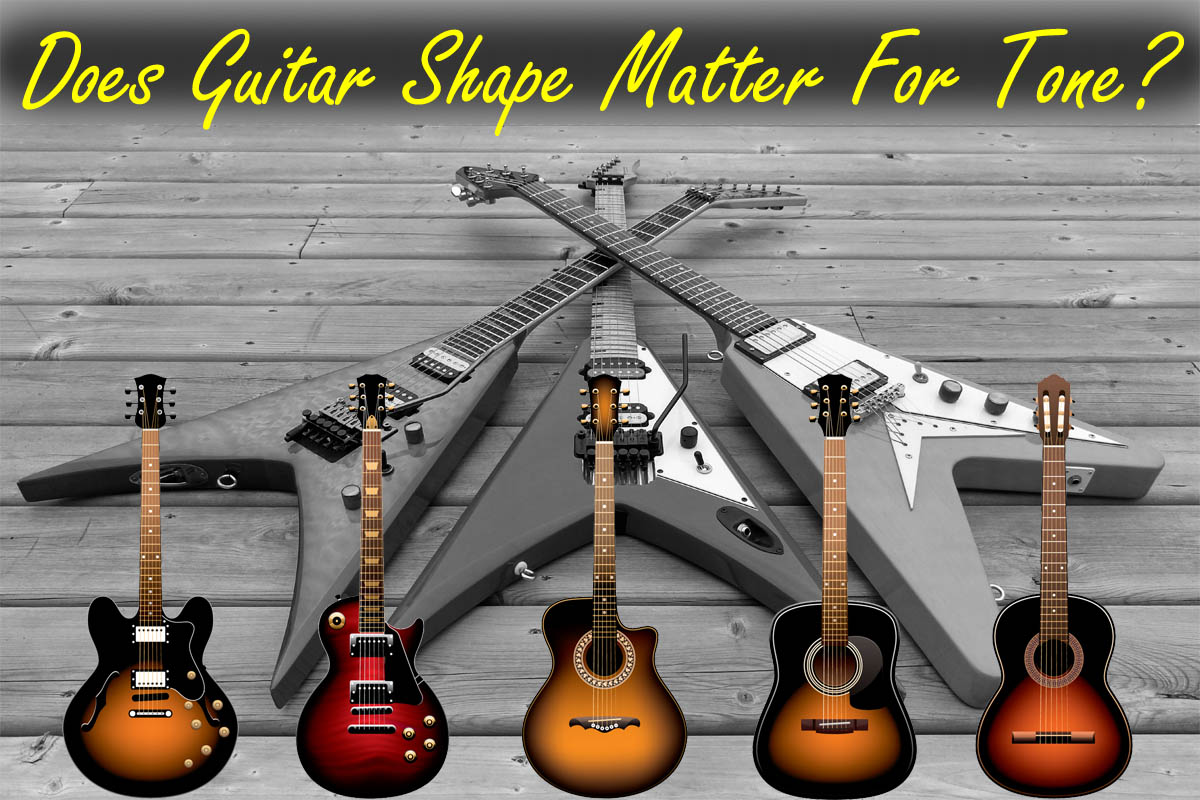Does Guitar Shape Really Matter For Tone? (Acoustic & Electric)
Different guitar brands are known for their distinctive sounds, but even more than that, the types of bodies on different models can determine the type of tone you get.
Guitar shape does affect tone, but it might not be the way that you think. There’s much more to it than just the simple shape of the guitar.
On acoustic guitars, larger bodies produce deeper more resonant sounds, however the specific shape of the guitar body can shape the sound even further. Solid body electric guitar shapes matter less for tone than acoustic guitars, while hollow-body electrics generally have less sustain.
If you’re trying to pick a guitar size and shape to get the tone you want, then you need some knowledge to guide you toward the guitars most suited to you.

Does Shape Matter More For Acoustic Guitar Than Electric?
Without a doubt, yes, shape is much more influential for acoustic guitar tone than for electrics. Electric guitars generate their sound through electromagnetic pulses that travel from the pickups to the amplifiers.
Because their sound is electric, then body shape has very little impact on tone.
However, there’s always an ongoing debate within the guitarist community as to how much shape affects tone, if at all. Some argue with empirical evidence that the shape very subtly impacts tone in that alterations in the shape transform how vibrations are transmitted.
Others argue that the tone projected from electric guitars is more greatly impacted by pickups and tonal woods rather than any minute differences shape would make.
How Acoustic Body Shape Affects Volume and Tone
The craftsmanship of acoustic guitars is extremely interesting because pretty much everything affects the volume and tone of an acoustic guitar: the grain structure, the density, the moisture content, the sap viability, how it’s cured, and even the length of time that it’s played.
The Bigger the Bolder
Acoustic guitars are especially affected by their body size and shape. Their size depicts how they respond and their body shape significantly impacts the sound and volume they are able to generate.
As a matter of fact, just about any alteration to the construction of an acoustic guitar will affect its sound including the type of bracing and whether or not it has a cutaway.
In essence, with acoustic guitars, the string vibrations also cause the soundboard (guitar top) to vibrate inside the guitar and then project outward through the soundhole.
- The larger the area inside the guitar, the deeper and louder the guitar will resonate.
- Additionally, the placement of the waist, internal bracing, and cutaways will all change how the vibrations travel throughout the chamber thereby impacting their tone.
- Cutaways, for example, cause guitars to sound brighter with reduced low tones.
- Additionally, guitars with larger body cavities will have more prominent bass while smaller-bodied guitars will have more pronounced treble, but also a better balance between the high end and the low end.
Much in the same way as electric guitars, the type of wood used in acoustics also alters the tone, volume, and richness of the guitar.
Harder woods facilitate brighter tones because sound waves are deflected; whereas, softer woods absorb the sound waves creating a warmer sound.
Jumbo Acoustic Guitars
Because they have large bodies and thin waists jumbos usually produce boisterous, deep, rich sounds with very resonant tones.
They have the most volume and sustain because they have a larger sound chamber making them both louder and snappier.
Dreadnought Acoustic Guitars
Dreadnoughts are typically one inch shorter than jumbos from the base of the body to the top of the neck. They are known as being one of the most versatile guitars on the market.
Not only are they designed to project big sound, but to also reflect crystal clear notes. Dreadnoughts are still known for their large presence in volume and tone, just not quite as bellowing as jumbos.
Auditorium and Parlor Acoustic Guitars
In contrast, the smaller body sizes of Parlour and Auditorium style bodies will naturally produce a smaller sound. These guitars tend to be brighter and high-end-oriented.
Their bass is usually faint, and lacking in volume and depth. They are often described as being thin, tinny, and bright.
Is Electric Guitar Shape Important For Tone?
The majority of guitarists argue that tone is less about the design and shape of the guitar and more about the weight and thickness of the guitar body.
The reason being is that guitar strings have more resonance and sustain with thicker and heavier bodies.
This means that the type of wood your guitar and fretboard are constructed with will have a much greater impact on its fullness and sustain rather than its shape.
Do Larger Electric Guitar Shapes Sound Different?
When it comes to electric guitars, larger shapes do not impact the sound in a way that you would think. Rather than size, sound is more persuaded by the wood types used in the construction of the guitar.
In addition to the tonal woods used, solid bodies, hollow bodies, and semi-hollow bodies will all have drastically different sounds.
For instance, solid bodies will have the greatest sustain proportional to their weight and thickness.
Whereas, hollow-bodies and semi-hollow bodies will have less sustain. Because there is less wood involved in their construction, they are traditionally lighter and thinner.
Do Round Shapes Sound Different To Angular Shapes?
Many guitarists will tell you that shape matters, but admittedly, only indirectly. It’s more of a chain reaction or domino effect.
Here’s how it really works.
We’ve already established that heavier, thicker bodies will produce more resonance and sustain. The sound resonating from your guitar is generated by the magnetic pickups secondary to the string vibrations.
The string vibrations are affected by the thickness and heaviness of the guitar body, and the thickness and heaviness of the body are a result of the type of wood used.
So you could say that the shape affects the weight based on the amount of wood used within any particular tonal wood, but the effect would be so minimal that it would hardly be noticed at all.
- For example, if you had a Les Paul and a Flying V both made of poplar, the sound difference would be so subtle you probably wouldn’t even be able to hear it.
- Whereas, if you had a Les Paul made of mahogany and a Flying V made of poplar, you’ve altered the weight and density of the guitar body, and therefore you will more likely be able to tell the difference in the tone of the guitar.
Does The Shape (Profile) Of A Guitar Neck Affect Tone?
As with guitar bodies, tone is affected much more by the type of wood used rather than the actual shape of the neck.
Many guitarists believe that neck wood affects the tonal response more so than the body itself.
The sound waves created by the vibration of the strings will either be reflected or absorbed by the neck of the guitar much in the same way as already discussed with the body.
Denser woods will produce brighter sounds and less sustain because they reflect the sounds and less dense woods will absorb sound.
Equally true, this significantly impacts acoustics more than electrics. However, neck woods can very much alter the sound a guitar produces, even if ever so slightly.
Tonal woods have a huge implication on the overall sound of the guitar, and each has its own distinguished reputation. So if you are seeking a particular sound then start by researching the tonal characteristics of popular woods.
Fingerboards & Tone
Another important factor is the fingerboard. In addition to the wood used to construct the neck, the tonal wood used for the fingerboard will also alter the sound.
For example, full maple necks will sound brighter and snappier while rosewood will project a more balanced articulate sound.
Take caution, however, in generalizing wood types for their sound because every piece of wood will vibrate differently and absorb at different frequencies.
Every guitar is unique, which is why it’s always important to try before you buy.
Neck Joints & Tone
Even the neck joint will have some effect on the tone. Particularly for electric guitars, the tighter the fit between the neck and the body, the more sustain and resonance the guitar will have.
Many electric guitarists believe that set necks and neck-throughs are warmer than bolt-on necks, which are typically deemed brighter.
Neck Size & Tone
As far as the actual neck profile, some guitarists believe that fatter necks produce a louder sound and that the tone can be different, but not necessarily better or worse.
Some argue that neck profiles impact acoustics more so than electrics in the same manner that bodies do.
And some will even go as far as to say that heavier headstocks enhance a guitar’s tone.
However, for a good majority of guitarists, most believe that the differences are so subtle that it’s purely subjective and that any presumed changes in tone are so minute that they are hardly noticeable to the average listener.
Final Thoughts
For guitarists, sound is extremely personal and subjective. Finding the right tone for your guitar is based on a number of factors, but mostly involve tonewoods of the body and neck.
Experimenting with sound is a big part of the fun in being a guitarist, as well as becoming a better musician.
Whether you’re just beginning or you’re a more evolved player, knowing what to look for when purchasing a guitar is half the battle. Understanding how body shape and various woods affect tone can help you nail that sublime sound that you’re looking for.




